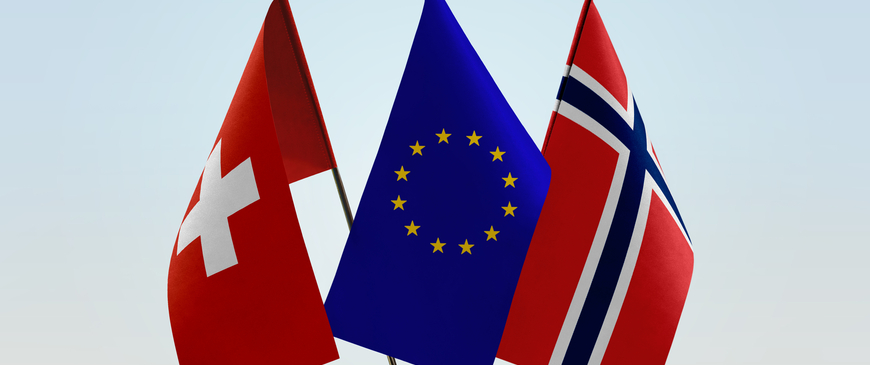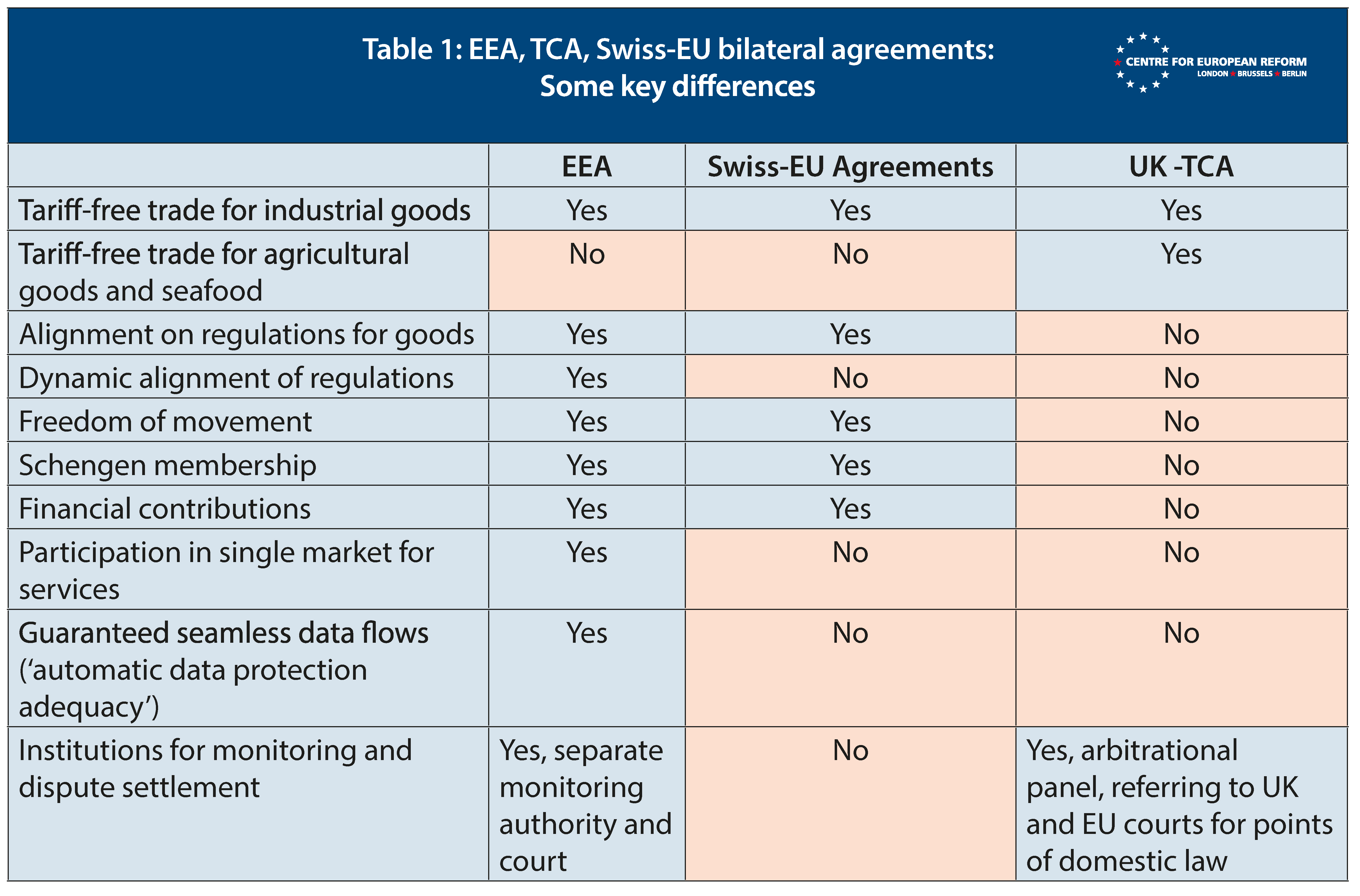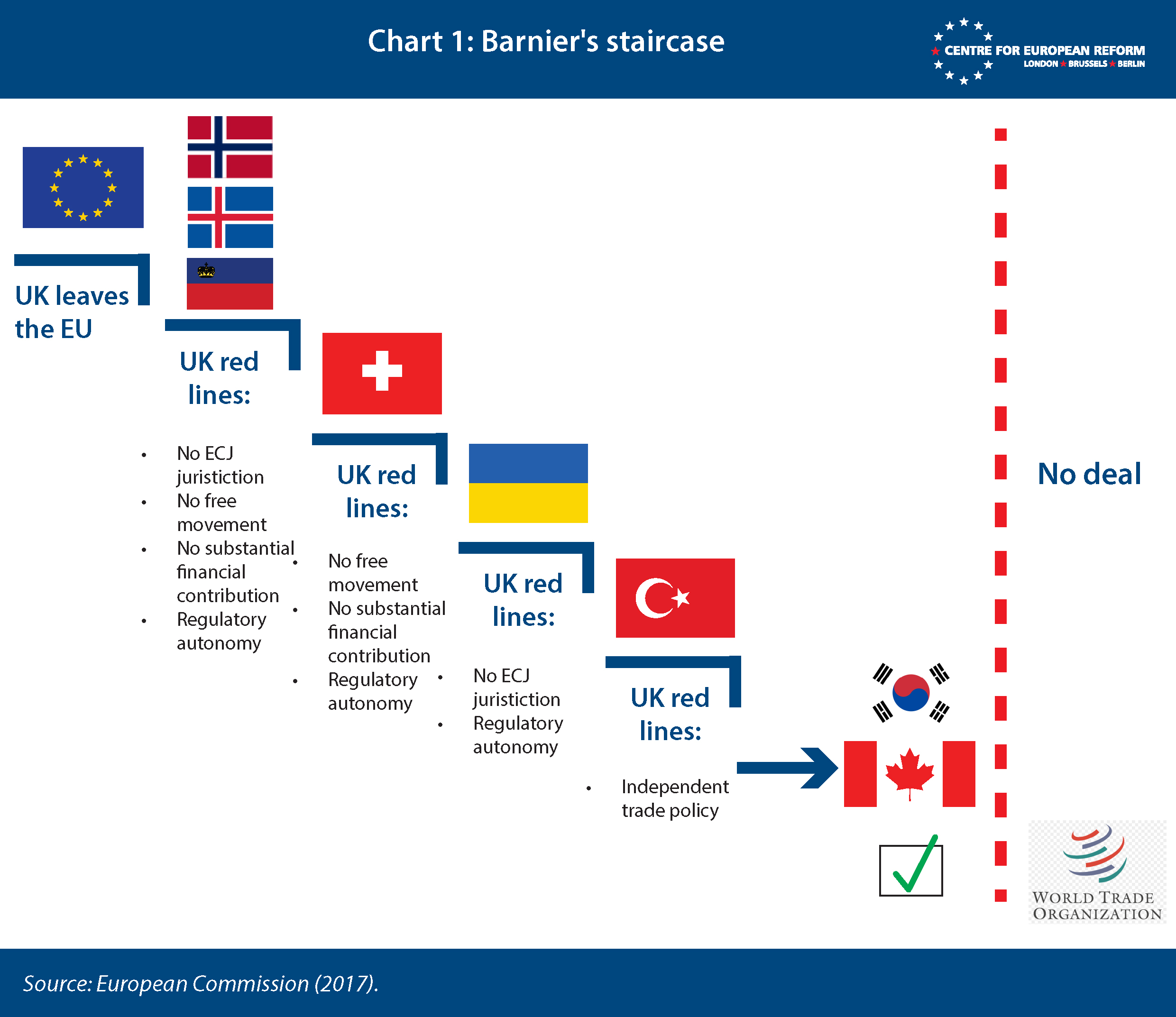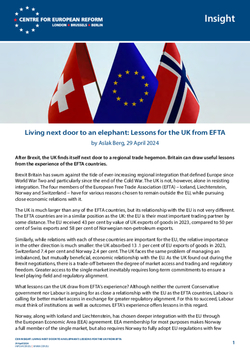
Living next door to an elephant: Lessons for the UK from EFTA
After Brexit, the UK finds itself next door to a regional trade hegemon. Britain can draw useful lessons from the experience of the EFTA countries.
Brexit Britain has swum against the tide of ever-increasing regional integration that defined Europe since World War Two and particularly since the end of the Cold War. The UK is not, however, alone in resisting integration. The four members of the European Free Trade Association (EFTA) – Iceland, Liechtenstein, Norway and Switzerland – have for various reasons chosen to remain outside the EU, while pursuing close economic relations with it.
The UK is much larger than any of the EFTA countries, but its relationship with the EU is not very different. The EFTA countries are in a similar position as the UK: the EU is their most important trading partner by some distance. The EU received 43 per cent by value of UK exports of goods in 2023, compared to 50 per cent of Swiss exports and 58 per cent of Norwegian non-petroleum exports.
Similarly, while relations with each of these countries are important for the EU, the relative importance in the other direction is much smaller: the UK absorbed 13 .1 per cent of EU exports of goods in 2023, Switzerland 7.4 per cent and Norway 2.4 per cent. The UK faces the same problem of managing an imbalanced, but mutually beneficial, economic relationship with the EU. As the UK found out during the Brexit negotiations, there is a trade-off between the degree of market access and trading and regulatory freedom. Greater access to the single market inevitably requires long-term commitments to ensure a level playing-field and regulatory alignment.
What lessons can the UK draw from EFTA’s experience? Although neither the current Conservative government nor Labour is arguing for as close a relationship with the EU as the EFTA countries, Labour is calling for better market access in exchange for greater regulatory alignment. For this to succeed, Labour must think of institutions as well as outcomes. EFTA’s experience offers lessons in this regard.
Norway, along with Iceland and Liechtenstein, has chosen deeper integration with the EU through the European Economic Area (EEA) agreement. EEA membership for most purposes makes Norway a full member of the single market, but also requires Norway to fully adopt EU regulations with few adaptations. The EEA also comes with a separate EFTA surveillance authority in lieu of the supervisory role the EU commission plays for EU member-states and a separate EFTA court in lieu of the European Court of Justice (ECJ). In practice, these serve as special-purpose mini-versions of EU institutions for EEA countries that follow ECJ jurisprudence.
Switzerland, having rejected EEA membership in a 1992 referendum, instead has a set of bilateral agreements that provide for free movement of people and regulatory alignment for goods as well as participation in some EU programmes. Instead of dynamic alignment with EU regulations, these agreements have to be updated manually as EU regulation changes. This has proved unsatisfactory for the EU, both due to insufficient dynamic alignment (in its view) and the lack of institutions to provide effective monitoring and dispute resolution. For their part, the Swiss have concerns about having to adopt EU state aid rules and about wage competition for cross-border services. Switzerland and the EU have tried to resolve these issues for many years and the EU is now refusing to update the older agreements until a satisfactory overall solution has been found. As a result, some alignment has started to lapse, notably on medical devices. That means increased trade costs for that sector, as Swiss exporters have to appoint local EU representatives to go through compliance procedures. Without updates to the agreement between the EU and Switzerland, this problem will gradually spread to other sectors as EU regulations continue to change.
If Britain wants a closer relationship with the EU in the future, it will have to pay as much attention to the process of alignment as to the outcome. A healthy relationship is based on healthy institutions.
In comparison with the EEA and the Swiss-EU bilateral agreements, the EU-UK Trade and Co-operation Agreement (TCA) does not provide for regulatory alignment and is in this respect more like a typical free trade agreement. But by global standards it is nevertheless ambitious. Unlike Switzerland and the EFTA countries, the UK is not particularly protectionist when it comes to agriculture and has therefore agreed to duty-free trade for agricultural goods, which no other major country has with the EU. This reflects the UK’s particular history as a former EU member and the desire to secure some of the economic relations established during that time. Similarly, while Iceland and Norway prefer to renegotiate their allocation of fishing quotas regularly, the UK-EU TCA has fixed allocations for five-year periods – largely reflecting preservation of the status quo. In return, the UK, unlike the EFTA countries, has duty-free market access for seafood to the EU.
However, the TCA does little to address non-tariff barriers such as sanitary regulation for foodstuffs and technical regulation for goods such as chemicals. The compliance costs are often higher than tariffs. This means that the UK overall enjoys a less close relationship with the EU than EFTA countries and Switzerland. Britain’s Labour party has already announced it will seek to reduce or eliminate non-tariff barriers should it win the next election, without going so far as to rejoin the EU’s single market or customs union.

Lesson 1: Institutions matter
The Swiss-EU bilateral agreements managed to achieve much of what Labour purports to want in lowering trade barriers through regulatory alignment. However, ultimately the agreements are failing, both because they are static and because of the lack of institutions to make them work. The process of updating them is cumbersome, the implementation is difficult to monitor and the lack of satisfactory dispute mechanisms ultimately made the EU unwilling to maintain them. The current negotiations between Switzerland and the EU will have to address all of these issues, and so will any future regulatory alignment between the EU and the UK.
EU regulations are adapted into EEA law through a lengthy process, where EEA states are involved at the technical level before decisions are adopted at the EU level, allowing for input and consultation. After an EU law is adopted, it is transformed into EEA law by joint agreement between the EEA and the EU, in a process that sometimes allows for small adaptations. This allows for EEA input, but contributes to occasional lengthy delays. In comparison, other agreements, like the one with Ukraine simply provides a time-table by which Ukraine must adopt EU law. Dynamic alignment akin to what happens in the EEA may not be available for the UK because of EU frustration with the delays and the presumably more limited scope of British alignment. But the UK should still reflect on whether it wants more than a time-table and if it would be possible for British officials to provide input as observers at the technical level before certain decisions on EU law are made. The fact that Northern Ireland has to adopt many EU regulations in any case would also argue in favour of stronger UK consultation rights.
Similarly, alignment requires monitoring to ensure correct implementation. This could be done by the European Commission, particularly if the breadth and depth of alignment is narrow, for instance if the scope is limited to a veterinary agreement and technical regulations for goods. If the alignment is wider and deeper, direct interventions by the Commission would need to be more frequent, which could create political tensions between the UK and EU. In such cases, an independent UK body like the one in the EEA mechanism would both help provide UK ownership of surveillance and help separate the management of the agreement from the overall EU-UK relationship.
Lastly, there needs to be an effective mechanism to settle disputes. The existing model under the TCA, which consists of an independent arbitration panel that defers any question of interpretation of domestic EU or UK law to domestic courts, might still be suitable for a more limited sectoral alignment on technical regulations for goods. However, in the case of more ambitious alignment, resolutions will quickly come down to interpretation of EU law and involve the European Court of Justice. For the EEA states, the EFTA Court serves a way to avoid sensitive questions around sovereignty and foreign judges. The ECJ is a careful guardian of its role as the sole interpreter of EU law, and the EFTA Court technically only rules on EEA law, not EU law – though in practice they are closely aligned, and the EFTA Court follows ECJ jurisprudence. If the UK were to seek a broader alignment, it would have to accept a more important and direct role for the ECJ. Alternatively, Britain could in theory also try to dock onto EEA institutions and EEA law without necessarily becoming a full EEA member. But in practice a new solution specifically for the UK seems more likely. However, any solution would be diplomatically and politically difficult to achieve.
Any type of alignment requires an adequate institutional framework – and the closer the alignment is the stronger and more developed the framework needs to be to withstand the political pressures that inevitably arise around sensitive issues of sovereignty. How will alignment be monitored and sustained? How will conflicts be resolved? What are the consequences if they are not? These are all issues that deserve much more attention than they are currently given.
Lesson 2: The relentless gravitational pull of the EU
As Europe’s dominant economic actor, the EU exerts a constant gravitational pull on all its neighbours, much like the US does in the Americas. However, unlike the US, the EU’s pull is stronger for two reasons. First, its architecture is more open, allowing its neighbours greater access to its markets than the US does, subject to accepting commensurate legal commitments and regulatory alignment. Second, as the EU expands in membership and deepens in integration, its gravitational pull strengthens further.
EFTA countries know that the gravitational pull of the EU is not just a constant presence – it also evolves with the EU itself. The UK should pay heed for its own relationship with the EU to succeed.
During the Brexit process, the EU’s chief negotiator Michel Barnier presented his now famous staircase representing the trade-off between autonomy and market access (see chart 1). The essential concept behind the graph remains correct, but it should not be conceived of as a closed menu, setting out the only concrete models which can be chosen. Instead, it simply shows the trade-offs that determine the possible scope of negotiation.

The EU has a reputation for being a tough and inflexible negotiator – an image it itself cultivates – but Barnier’s staircase shows the EU’s creativity in negotiating trading arrangements that respects the red lines of both the EU itself and its negotiating partner. The EU may like to portray the single market as indivisible, but the EEA has carved out exemptions for fishing and agriculture. Switzerland de facto participates in the single market for goods, but not for services. The UK has a free trade agreement like Canada, but the UK level of market access far exceeds that of Canada and comes with far greater commitments in many areas, such as state aid. The consistency is in the trade-off between higher alignment and greater access in exchange for autonomy, and the emphasis on monitoring and enforcement.
The EU is an attractive negotiating partner precisely because it combines vast market size with a certain level of tough flexibility. There is, after all, no point in engaging if nothing can be achieved. The EEA countries, for instance, managed to achieve full membership of the European Defence Fund based on their generally good relationship with the EU and willingness to contribute financially, even if there is nothing in the EEA agreement that would necessarily require the EU to give them access. Swiss-EU relations have been more difficult as of late, and the EU has not been afraid to use its stick by freezing participation in programmes and letting deals lapse. However, there is still a strong incentive to negotiate based on mutual willingness to engage and find compromises.
Similarly, when the EU integrates further internally, it unwittingly increases its gravitational pull and pressures its neighbours to do so too. The EEA countries have experienced this with the appearance of EU agencies that are now essential to the functioning of the single market, but were not predicted by the EEA agreement itself. To maintain alignment and full participation, EEA countries have therefore had to seek participation in institutions that did not exist when the EEA was first created. Norway for instance, is involved at some level in 31 different EU agencies, some of which, like the Agency for the Co-operation of Energy Regulators have proved controversial in domestic debate. This underscores that dynamic alignment is an ongoing process that mirrors the evolution of the EU, both at the regulatory and the institutional level.
Conclusions
The experience of the EFTA countries shows both the benefits and the inconveniences of being the EU’s neighbour. The EU is a reliable partner that can be flexible when it suits it. At the same time, it is an economic giant and a tough negotiator that is not afraid of throwing its weight around when it wants. And the combination of its size, relative openness and continued integration means that it inevitably draws in its neighbours in a constant pull.
The UK may neither want nor be able to adopt the Swiss model or the Norwegian model. But there are still valuable lessons to be drawn from EFTA’s experience with the EU.
For the UK, there is little reason to pick any of the EFTA countries as a model. Given its own history with the EU, the UK must build from where it is rather than on what others have achieved. However, the experience of the EFTA countries holds some useful lessons in how to navigate relations with the EU to shape a uniquely British model: pay attention to process and institutions, know that the existence of EU red lines does not prevent the EU from being flexible when it wants, and be aware that there will be a constant incentive to engage and negotiate.
Aslak Berg is a research fellow at the Centre for European Reform.


Add new comment